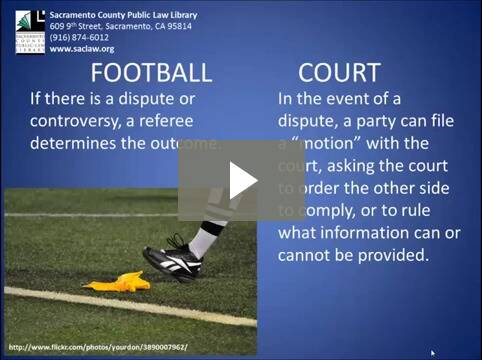Steps in a Lawsuit: Overview

If You Understand Football You Can Understand a Civil Court Case
First Round: Complaint and Answer
The first step in any lawsuit is that the person who believes they have been wronged — the plaintiff — files a Summons and Complaint (or in some cases, a Petition) and has it served on the defendant or defendants. (See our guide on Filing a Complaint to Start a Civil Lawsuit in California for more information.)
Service of Summons and Complaint
The plaintiff must ensure that the defendant(s) get notice of the lawsuit by complying with strict rules on service of the summons and complaint.
- The plaintiff cannot serve the papers themselves. They must hire the sheriff or a process server, or ask someone who is not a party, to do it.
- The server must deliver the papers to the defendant in person (if they cannot locate the person after three tries, they can leave it with an adult at the defendant’s home or work, then mail a back-up copy to the defendant. This is called “substituted service.”)
- The server must then fill out and sign a Proof of Service of Summons. If they used substituted service, they must also fill out a Declaration of Diligence describing all the times they tried to serve the person before leaving it with someone else and mailing it.
For more on personal service, see our guide on Personal Service and our video on How to Accomplish Personal Service of Court Papers.
Defendant’s Response
After the defendant is served, they can:
- choose not to respond (default), in which case the plaintiff can request a judgment immediately, without trial (see our guides on Requesting a Default Judgment by Clerk and Requesting a Default Judgment by Court);
- try to settle the case; or
- file a response, typically an Answer.
(See our guide on Responding to a Lawsuit or Responding to a Debt Collection Lawsuit for more information.)
After the Answer: Next Steps
If the defendant files an Answer (or other response), the parties begin the long process of preparing for trial. There will be many more documents to file and serve throughout the lawsuit.
It will likely be several months before there is any kind of court hearing. Parties, including self-represented litigates, are responsible for knowing what is happening in their case. In Sacramento County, civil records are online at the Court’s Public Portal. Be sure to check often, to make sure you’re not missing anything.
Case Management Statements and Conferences
The court requires periodic status reports from the parties, called the Case Management Statement (CM-110). The court will mail out a Notice of Case Management Conference, setting a date for the first conference; it will be set approximately six months after the case is filed. The parties must file a Case Management Statement no later than fifteen days before the case management conference.
You can find more info on Case Management Statements on our website at Case Management Statement Guide and free video (Filling out Case Management Statement (CM-110)).
Sacramento: No Case Management Conferences in Limited Cases
The Sacramento court has exempted limited cases (demand less than $25,000, or $35,000 after Jan. 1, 2024), from the requirement of status conferences. When parties are ready for trial, they file a Limited Civil Case Status Memorandum (CV/E-202), a Sacramento County Superior Court local form requesting trial and letting the judge know how many hours the party expects the trial to take, and whether the party wants a jury. You can find more info and a sample form in our Limited Civil Case Memorandum guide.
Discovery
Discovery is the formal process of exchanging documents, evidence, and other information before going to court. For more information, see:
- Discovery: Gather Information for your Case and related guides on this website.
- Our Discovery Video series: in-depth look at creating and responding to common types of discovery requests.
- Win Your Lawsuit, Chapter 10. Available in the Law Library.
Motions
When parties need a court order, they file a motion with the court (and serve it on the other party) by choosing a hearing date and presenting paperwork including a Notice of Motion, Motion, Memorandum of Points and Authorities, and Declaration(s). The other party then has the opportunity to write an Opposition. Typical motions request the judge to order one party to comply with discovery or deal with other pre-trial issues. These are called “law and motion” hearings.
In Sacramento, they are held in Department 53 at 2 p.m. and Department 54 at 9 a.m. Your case is assigned to one or the other department when it is filed.
- For cases filed since about April 15, 2023: check your case file online to find which department you are assigned to.
- For cases filed before then, if your case number is odd, it was assigned to Department 53. If it is even, it was assigned to Department 54.
For more information, instructions, and sample paperwork, see our guide, “Motions in Civil Cases.”
Tentative Ruling System
In Sacramento County (and many California counties), Case Management Orders and most types of motions are subject to the Tentative Ruling process. For these types of proceedings, the judge makes a decision by 2 p.m. the court day before the scheduled hearing date. Check online by looking up your case in the Court’s Public Portal. Unless one of the parties asks for oral argument by 4 p.m. that same day, the tentative ruling will become the final ruling automatically.
If you would like to speak to the judge before the ruling is final, you must notify the other party’s attorney (or the party, if self-represented), and the department clerk that you plan to appear. Do this no later than 4 p.m. the day before. If neither party gives this notice, your hearing will be canceled and the tentative ruling becomes final. Visit the Sacramento court’s website for more information on the Tentative Ruling System in the Sacramento Superior Court.
Trial Preparation
Most cases take a year or more to get to trial, if they don’t settle before then. If you get close to trial, you will need to gather evidence and prepare your presentation. For more information about this, you can use the book Win Your Lawsuit or one of our many practice guides. You can also view our free video, Trial Preparation for the Self Represented Litigant, for information and tips.
This material is intended as general information only. Your case may have factors requiring different procedures or forms. The information and instructions are provided for use in the Sacramento County Superior Court. Please keep in mind that each court may have different requirements. If you need further assistance consult a lawyer.




